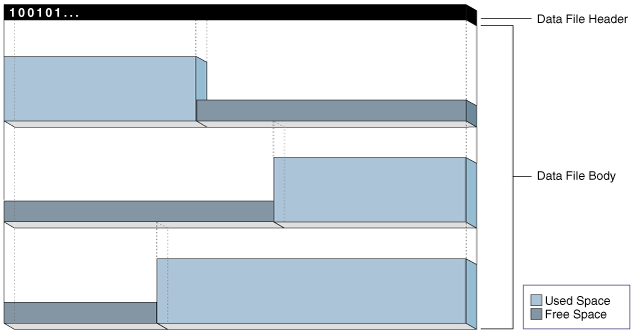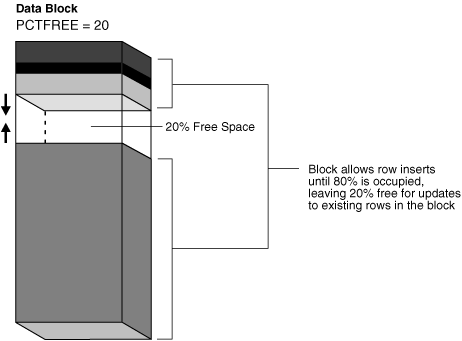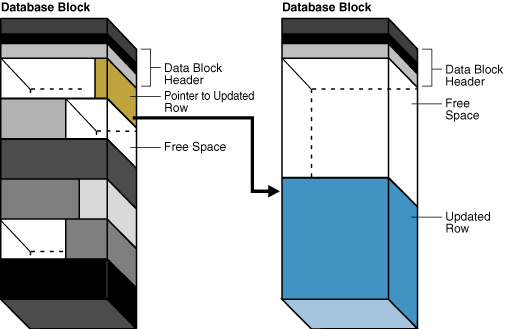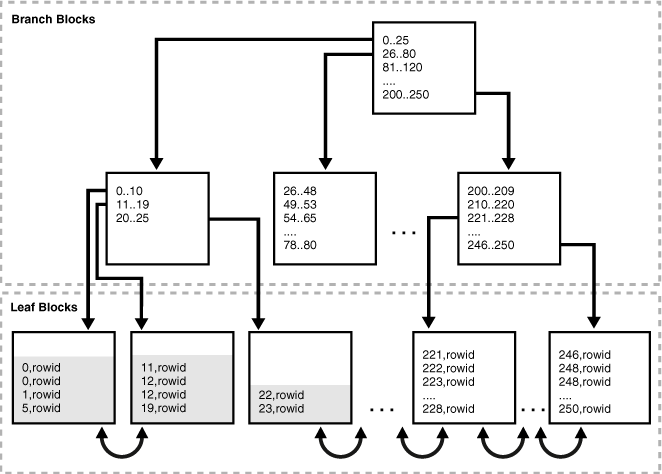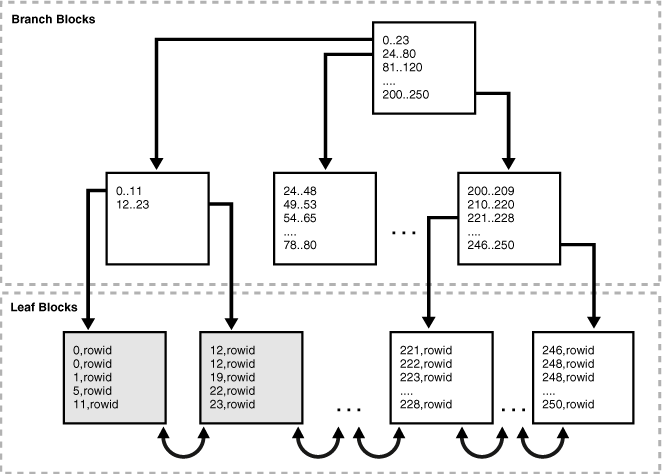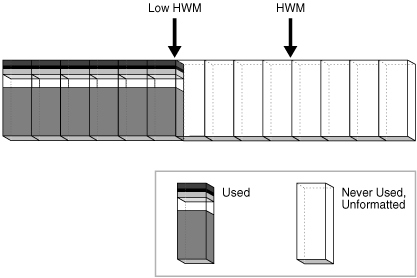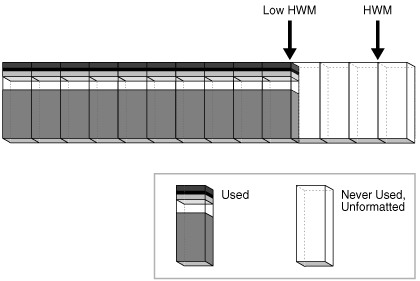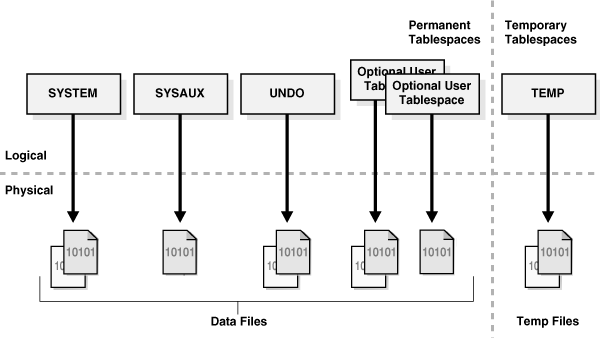12 Logical Storage Structures
This chapter describes the nature of and relationships among logical storage structures. These structures are created and recognized by Oracle Database and are not known to the operating system.
Introduction to Logical Storage Structures
Oracle Database allocates logical space for all data in the database. The logical units of database space allocation are data blocks, extents, segments, and tablespaces. At a physical level, the data is stored in data files on disk (see Physical Storage Structures). The data in the data files is stored in operating system blocks.
Figure 12-1 is an entity-relationship diagram for physical and logical storage. The crow's foot notation represents a one-to-many relationship.
Logical Storage Hierarchy
Figure 12-2 shows the relationships among data blocks, extents, and segments within a tablespace. In this example, a segment has two extents stored in different data files.
Figure 12-2 Segments, Extents, and Data Blocks Within a Tablespace

Description of "Figure 12-2 Segments, Extents, and Data Blocks Within a Tablespace"
At the finest level of granularity, Oracle Database stores data in data blocks. One logical data block corresponds to a specific number of bytes of physical disk space, for example, 2 KB. Data blocks are the smallest units of storage that Oracle Database can use or allocate.
An extent is a set of logically contiguous data blocks allocated for storing a specific type of information. In Figure 12-2, the 24 KB extent has 12 data blocks, while the 72 KB extent has 36 data blocks.
A segment is a set of extents allocated for a specific database object, such as a table. For example, the data for the employees table is stored in its own data segment, whereas each index for employees is stored in its own index segment. Every database object that consumes storage consists of a single segment.
Each segment belongs to one and only one tablespace. Thus, all extents for a segment are stored in the same tablespace. Within a tablespace, a segment can include extents from multiple data files, as shown in Figure 12-2. For example, one extent for a segment may be stored in users01.dbf, while another is stored in users02.dbf. A single extent can never span data files.
See Also:
Logical Space Management
Oracle Database must use logical space management to track and allocate the extents in a tablespace. When a database object requires an extent, the database must have a method of finding and providing it. Similarly, when an object no longer requires an extent, the database must have a method of making the free extent available.
Oracle Database manages space within a tablespace based on the type that you create. You can create either of the following types of tablespaces:
-
Locally managed tablespaces (default)
The database uses bitmaps in the tablespaces themselves to manage extents. Thus, locally managed tablespaces have a part of the tablespace set aside for a bitmap. Within a tablespace, the database can manage segments with automatic segment space management (ASSM) or manual segment space management (MSSM).
-
Dictionary-managed tablespaces
The database uses the data dictionary to manage extents (see "Overview of the Data Dictionary").
Figure 12-3 shows the alternatives for logical space management in a tablespace.
Locally Managed Tablespaces
A locally managed tablespace maintains a bitmap in the data file header to track free and used space in the data file body. Each bit corresponds to a group of blocks. When space is allocated or freed, Oracle Database changes the bitmap values to reflect the new status of the blocks.
The following graphic is a conceptual representation of bitmap-managed storage. A 1 in the header refers to used space, whereas a 0 refers to free space.
A locally managed tablespace has the following advantages:
-
Avoids using the data dictionary to manage extents
Recursive operations can occur in dictionary-managed tablespaces if consuming or releasing space in an extent results in another operation that consumes or releases space in a data dictionary table or undo segment.
-
Tracks adjacent free space automatically
In this way, the database eliminates the need to coalesce free extents.
-
Determines the size of locally managed extents automatically
Alternatively, all extents can have the same size in a locally managed tablespace and override object storage options.
Note:
Oracle strongly recommends the use of locally managed tablespaces with Automatic Segment Space Management.
Segment space management is an attribute inherited from the tablespace that contains the segment. Within a locally managed tablespace, the database can manage segments automatically or manually. For example, segments in tablespace users can be managed automatically while segments in tablespace tools are managed manually.
Automatic Segment Space Management
The automatic segment space management (ASSM) method uses bitmaps to manage space in a tablespace.
Bitmaps provide the following advantages:
-
Simplified administration
ASSM avoids the need to manually determine correct settings for many storage parameters. Only one crucial SQL parameter controls space allocation:
PCTFREE. This parameter specifies the percentage of space to be reserved in a block for future updates (see "Percentage of Free Space in Data Blocks"). -
Increased concurrency
Multiple transactions can search separate lists of free data blocks, thereby reducing contention and waits. For many standard workloads, application performance with ASSM is better than the performance of a well-tuned application that uses MSSM.
-
Dynamic affinity of space to instances in an Oracle Real Application Clusters (Oracle RAC) environment
ASSM is more efficient and is the default for permanent, locally managed tablespaces.
Note:
This chapter assumes the use of ASSM in all of its discussions of logical storage space.
Manual Segment Space Management
The legacy manual segment space management (MSSM) method uses a linked list called a free list to manage free space in the segment. For a database object that has free space, a free list keeps track of blocks under the high water mark (HWM) (HWM), which is the dividing line between segment space that is used and not yet used. As blocks are used, the database puts blocks on or removes blocks from the free list as needed.
In addition to PCTFREE, MSSM requires you to control space allocation with SQL parameters such as PCTUSED, FREELISTS, and FREELIST GROUPS. PCTUSED sets the percentage of free space that must exist in a currently used block for the database to put it on the free list. For example, if you set PCTUSED to 40 in a CREATE TABLE statement, then you cannot insert rows into a block in the segment until less than 40% of the block space is used.
For example, suppose you insert a row into a table. The database checks a free list of the table for the first available block. If the row does not fit in the block, and if the used space in the block is greater than or equal to PCTUSED, then the database removes the block from the list and searches for another block. If you delete rows from the block, then the database checks whether used space in the block is now less than PCTUSED. If so, then the database places the block at the beginning of the free list.
An object may have multiple free lists. In this way, multiple sessions performing DML on a table can use different lists, which can reduce contention. Each database session uses only one free list for the duration of its session.
As shown in Figure 12-4, you can also create an object with one or more free list groups, which are collections of free lists. Each group has a master free list that manages the individual process free list in the group. Space overhead for free lists, especially for free list groups, can be significant.
Managing segment space manually can be complex. You must adjust PCTFREE and PCTUSED to reduce row migration (see "Chained and Migrated Rows ") and avoid wasting space. For example, if every used block in a segment is half full, and if PCTUSED is 40, then the database does not permit inserts into any of these blocks. Because of the difficulty of fine-tuning space allocation parameters, Oracle strongly recommends ASSM. In ASSM, PCTFREE determines whether a new row can be inserted into a block, but it does not use free lists and ignores PCTUSED.
See Also:
-
Oracle Database Administrator's Guide to learn about locally managed tablespaces
-
Oracle Database Administrator's Guide to learn more about automatic segment space management
-
Oracle Database SQL Language Reference to learn about storage parameters such as
PCTFREEandPCTUSED
Dictionary-Managed Tablespaces
A dictionary-managed tablespace uses the data dictionary to manage its extents. Oracle Database updates tables in the data dictionary whenever an extent is allocated or freed for reuse. For example, when a table needs an extent, the database queries the data dictionary tables, and searches for free extents. If the database finds space, then it modifies one data dictionary table and inserts a row into another. In this way, the database manages space by modifying and moving data.
The SQL that the database executes in the background to obtain space for database objects is recursive SQL. Frequent use of recursive SQL can have a negative impact on performance because updates to the data dictionary must be serialized. Locally managed tablespaces, which are the default, avoid this performance problem.
See Also:
Oracle Database Administrator's Guide to learn how to migrate tablespaces from dictionary-managed to locally managed
Overview of Data Blocks
Oracle Database manages the logical storage space in the data files of a database in a unit called a data block, also called an Oracle block or page. A data block is the minimum unit of database I/O.
Data Blocks and Operating System Blocks
At the physical level, database data is stored in disk files made up of operating system blocks. An operating system block is the minimum unit of data that the operating system can read or write. In contrast, an Oracle block is a logical storage structure whose size and structure are not known to the operating system.
Figure 12-5 shows that operating system blocks may differ in size from data blocks. The database requests data in multiples of data blocks, not operating system blocks.
Figure 12-5 Data Blocks and Operating System Blocks
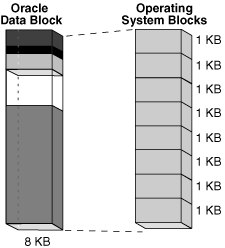
Description of "Figure 12-5 Data Blocks and Operating System Blocks"
When the database requests a data block, the operating system translates this operation into a requests for data in permanent storage. The logical separation of data blocks from operating system blocks has the following implications:
-
Applications do not need to determine the physical addresses of data on disk.
-
Database data can be striped or mirrored on multiple physical disks.
Database Block Size
Every database has a database block size. The DB_BLOCK_SIZE initialization parameter sets the data block size for a database when it is created. The size is set for the SYSTEM and SYSAUX tablespaces and is the default for all other tablespaces. The database block size cannot be changed except by re-creating the database.
If DB_BLOCK_SIZE is not set, then the default data block size is operating system-specific. The standard data block size for a database is 4 KB or 8 KB. If the size differs for data blocks and operating system blocks, then the data block size must be a multiple of the operating system block size.
See Also:
-
Oracle Database Reference to learn about the
DB_BLOCK_SIZEinitialization parameter -
Oracle Database Administrator's Guide and Oracle Database Performance Tuning Guide to learn how to choose block sizes
Tablespace Block Size
You can create individual tablespaces whose block size differs from the DB_BLOCK_SIZE setting. A nonstandard block size can be useful when moving a transportable tablespace to a different platform.
See Also:
Oracle Database Administrator's Guide to learn how to specify a nonstandard block size for a tablespace
Data Block Format
Every data block has a format or internal structure that enables the database to track the data and free space in the block. This format is similar whether the data block contains table, index, or table cluster data. Figure 12-6 shows the format of an uncompressed data block (see "Data Block Compression" to learn about compressed blocks).
Data Block Overhead
Oracle Database uses the block overhead to manage the block itself. The block overhead is not available to store user data. As shown in Figure 12-6, the block overhead includes the following parts:
-
This part contains general information about the block, including disk address and segment type. For blocks that are transaction-managed, the block header contains active and historical transaction information.
A transaction entry is required for every transaction that updates the block. Oracle Database initially reserves space in the block header for transaction entries. In data blocks allocated to segments that support transactional changes, free space can also hold transaction entries when the header space is depleted. The space required for transaction entries is operating system dependent. However, transaction entries in most operating systems require approximately 23 bytes.
-
For a heap-organized table, this directory contains metadata about tables whose rows are stored in this block. In a table cluster, multiple tables can store rows in the same block.
-
Row directory
For a heap-organized table, this directory describes the location of rows in the data portion of the block. The database can place a row anywhere in the bottom of the block. The row address is recorded in one of the slots of the row directory vector.
A rowid points to a specific file, block, and row number. For example, in the rowid
AAAPecAAFAAAABSAAA, the finalAAArepresents the row number. The row number is an index into an entry in the row directory. The row directory entry contains a pointer to the location of the row on the data block. If the database moves a row within a block, then the database updates the row directory entry to modify the pointer. The rowid stays constant.After the database allocates space in the row directory, the database does not reclaim this space after deleting rows. Thus, a block that is currently empty but formerly had up to 50 rows continues to have 100 bytes allocated for the row directory. The database reuses this space only when a session inserts new rows in the block.
Some parts of the block overhead are fixed in size, but the total size is variable. On average, the block overhead totals 84 to 107 bytes.
Row Format
The row data part of the block contains the actual data, such as table rows or index key entries. Just as every data block has an internal format, every row has a row format that enables the database to track the data in the row.
Oracle Database stores rows as variable-length records. A row is contained in one or more sections. Each section is called a row piece. Each row piece has a row header and column data.
Figure 12-7 shows the format of a row.
Row Header
Oracle Database uses the row header to manage the row piece stored in the block.
The row header contains information such as the following:
-
Columns in the row piece
-
Pieces of the row located in other data blocks
If an entire row can be inserted into a single data block, then Oracle Database stores the row as one row piece. However, if all of the row data cannot be inserted into a single block or an update causes an existing row to outgrow its block, then the database stores the row in multiple row pieces. A data block usually contains only one row piece per row.
-
Cluster keys for table clusters
A row fully contained in one block has at least 3 bytes of row header.
See Also:
Column Data
After the row header, the column data section stores the actual data in the row. The row piece usually stores columns in the order listed in the CREATE TABLE statement, but this order is not guaranteed. For example, columns of type LONG are created last.
As shown in Figure 12-7, for each column in a row piece, Oracle Database stores the column length and data separately. The space required depends on the data type. If the data type of a column is variable length, then the space required to hold a value can grow and shrink with updates to the data.
Each row has a slot in the row directory of the data block header. The slot points to the beginning of the row.
See Also:
"Table Storage" and "Index Storage"
Rowid Format
Oracle Database uses a rowid to uniquely identify a row. Internally, the rowid is a structure that holds information that the database needs to access a row. A rowid is not physically stored in the database, but is inferred from the file and block on which the data is stored.
An extended rowid includes a data object number. This rowid type uses a base 64 encoding of the physical address for each row. The encoding characters are A-Z, a-z, 0-9, +, and /.
Example 12-1 ROWID Pseudocolumn
The following example queries the ROWID pseudocolumn to show the extended rowid of the row in the employees table for employee 100:
SQL> SELECT ROWID FROM employees WHERE employee_id = 100; ROWID ------------------ AAAPecAAFAAAABSAAA
Figure 12-8 illustrates the format of an extended rowid.
An extended rowid is displayed in a four-piece format, OOOOOOFFFBBBBBBRRR, with the format divided into the following components:
-
OOOOOOThe data object number identifies the segment (data object
AAAPecin the sample query). A data object number is assigned to every database segment. Schema objects in the same segment, such as a table cluster, have the same data object number. -
FFFThe tablespace-relative data file number identifies the data file that contains the row (file
AAFin the sample query). -
BBBBBBThe data block number identifies the block that contains the row (block
AAAABSin the sample query). Block numbers are relative to their data file, not their tablespace. Thus, two rows with identical block numbers could reside in different data files of the same tablespace. -
RRRThe row number identifies the row in the block (row
AAAin the sample query).
After a rowid is assigned to a row piece, the rowid can change in special circumstances. For example, if row movement is enabled, then the rowid can change because of partition key updates, Flashback Table operations, shrink table operations, and so on. If row movement is disabled, then a rowid can change if the row is exported and imported using Oracle Database utilities.
Note:
Internally, the database performs row movement as if the row were physically deleted and reinserted. However, row movement is considered an update, which has implications for triggers.
See Also:
-
Oracle Database SQL Language Reference to learn about rowids
Data Block Compression
The database can use table compression to eliminate duplicate values in a data block (see "Table Compression"). This section describes the format of data blocks that use compression.
The format of a data block that uses basic table and advanced row compression is essentially the same as an uncompressed block. The difference is that a symbol table at the beginning of the block stores duplicate values for the rows and columns. The database replaces occurrences of these values with a short reference to the symbol table.
Example 12-2 Format of Compressed Data Blocks
Assume that the following rows are stored in a data block for the seven-column sales table:
2190,13770,25-NOV-00,S,9999,23,161 2225,15720,28-NOV-00,S,9999,25,1450 34005,120760,29-NOV-00,P,9999,44,2376 9425,4750,29-NOV-00,I,9999,11,979 1675,46750,29-NOV-00,S,9999,19,1121
When basic table or advanced row compression is applied to this table, the database replaces duplicate values with a symbol reference. The following conceptual representation of the compression shows the symbol * replacing 29-NOV-00 and % replacing 9999:
2190,13770,25-NOV-00,S,%,23,161 2225,15720,28-NOV-00,S,%,25,1450 34005,120760,*,P,%,44,2376 9425,4750,*,I,%,11,979 1675,46750,*,S,%,19,1121
Table 12-1 conceptually represents the symbol table that maps symbols to values.
Table 12-1 Symbol Table
| Symbol | Value | Column | Rows |
|---|---|---|---|
|
* |
29-NOV-00 |
3 |
958-960 |
|
% |
9999 |
5 |
956-960 |
Space Management in Data Blocks
As the database fills a data block from the bottom up, the amount of free space between the row data and the block header decreases. This free space can also shrink during updates, as when changing a trailing null to a nonnull value. The database manages free space in the data block to optimize performance and avoid wasted space.
Note:
This section assumes the use of automatic segment space management.
Percentage of Free Space in Data Blocks
The PCTFREE storage parameter is essential to how the database manages free space. This SQL parameter sets the minimum percentage of a data block reserved as free space for updates to existing rows. Thus, PCTFREE is important for preventing row migration and avoiding wasted space.
For example, assume that you create a table that will require only occasional updates, most of which will not increase the size of the existing data. You specify the PCTFREE parameter within a CREATE TABLE statement as follows:
CREATE TABLE test_table (n NUMBER) PCTFREE 20;
Figure 12-9 shows how a PCTFREE setting of 20 affects space management. The database adds rows to the block over time, causing the row data to grow upwards toward the block header, which is itself expanding downward toward the row data. The PCTFREE setting ensures that at least 20% of the data block is free. For example, the database prevents an INSERT statement from filling the block so that the row data and header occupy a combined 90% of the total block space, leaving only 10% free.
Note:
This discussion does not apply to LOB data types, which do not use the PCTFREE storage parameter or free lists. See "Overview of LOBs".
See Also:
Oracle Database SQL Language Reference for the syntax and semantics of the PCTFREE parameter
Optimization of Free Space in Data Blocks
While the percentage of free space cannot be less than PCTFREE, the amount of free space can be greater. For example, setting PCTFREE to 20% prevents the total amount of free space from dropping to 5% of the block, but allows 50% of the block to be free.
Optimization by Increasing Free Space
The following DML statements can increase free space in data blocks:
-
DELETEstatements -
UPDATEstatements that either update existing values to smaller values or increase existing values and force a row to migrate -
INSERTstatements on a table that uses advanced row compressionIf
INSERTstatements fill a block with data, then the database invokes block compression, which may result in the block having more free space.
The space released is available for INSERT statements under the following conditions:
-
If the
INSERTstatement is in the same transaction and after the statement that frees space, then the statement can use the space. -
If the
INSERTstatement is in a separate transaction from the statement that frees space (perhaps run by another user), then the statement can use the space made available only after the other transaction commits and only if the space is needed.
See Also:
Oracle Database Administrator's Guide to learn about advanced row compression
Optimization by Coalescing Fragmented Space
Released space may or may not be contiguous with the main area of free space in a data block, as shown in Figure 12-10. Noncontiguous free space is called fragmented space.
Figure 12-10 Data Block with Fragmented Space
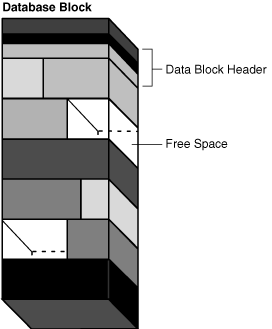
Description of "Figure 12-10 Data Block with Fragmented Space"
Oracle Database automatically and transparently coalesces the free space of a data block only when the following conditions are true:
-
An
INSERTorUPDATEstatement attempts to use a block that contains sufficient free space to contain a new row piece. -
The free space is fragmented so that the row piece cannot be inserted in a contiguous section of the block.
After coalescing, the amount of free space is identical to the amount before the operation, but the space is now contiguous. Figure 12-11 shows a data block after space has been coalesced.
Figure 12-11 Data Block After Coalescing Free Space
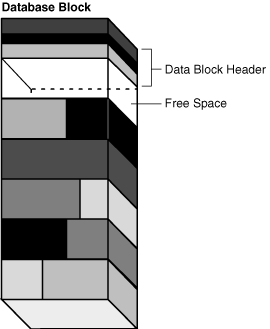
Description of "Figure 12-11 Data Block After Coalescing Free Space"
Oracle Database performs coalescing only in the preceding situations because otherwise performance would decrease because of the continuous coalescing of the free space in data blocks.
Chained and Migrated Rows
Oracle Database must manage rows that are too large to fit into a single block. The following situations are possible:
-
The row is too large to fit into one data block when it is first inserted.
In row chaining, Oracle Database stores the data for the row in a chain of one or more data blocks reserved for the segment. Row chaining most often occurs with large rows. Examples include rows that contain a column of data type
LONGorLONGRAW, or a row with a huge number of columns. Row chaining in these cases is unavoidable. -
A row that originally fit into one data block is updated so that the overall row length increases, but insufficient free space exists to hold the updated row.
In row migration, Oracle Database moves the entire row to a new data block, assuming the row can fit in a new block. The original row piece of a migrated row contains a pointer or "forwarding address" to the new block containing the migrated row. The rowid of a migrated row does not change.
-
A row has more than 255 columns.
Oracle Database can only store 255 columns in a row piece. Thus, if you insert a row into a table that has 1000 columns, then the database creates 4 row pieces, typically chained over multiple blocks.
Figure 12-12 depicts shows the insertion of a large row in a data block. The row is too large for the left block, so the database chains the row by placing the first row piece in the left block and the second row piece in the right block.
Figure 12-13, the left block contains a row that is updated so that the row is now too large for the block. The database moves the entire row to the right block and leaves a pointer to the migrated row in the left block.
When a row is chained or migrated, the I/O needed to retrieve the data increases. This situation results because Oracle Database must scan multiple blocks to retrieve the information for the row. For example, if the database performs one I/O to read an index and one I/O to read a nonmigrated table row, then an additional I/O is required to obtain the data for a migrated row.
The Segment Advisor, which can be run both manually and automatically, is an Oracle Database component that identifies segments that have space available for reclamation. The advisor can offer advice about objects that have significant free space or too many chained rows.
See Also:
-
"Row Storage" and "Rowids of Row Pieces "
-
Oracle Database Administrator's Guide to learn how to reclaim wasted space
-
Oracle Database Performance Tuning Guide to learn about reducing chained and migrated rows
Overview of Index Blocks
An index block is a special type of data block that manages space differently from table blocks. Oracle Database uses index blocks to manage the logical storage space in an index.
Types of Index Blocks
An index contains the following basic types of blocks:
-
Root block
This block identifies the entry point into the index.
-
Branch blocks
The databases navigates through branch blocks when searching for an index key.
-
Leaf blocks
These blocks contain the indexed key values rowids that point to the associated rows in a table. The leaf blocks store key values in sorted order so that the database can search efficiently for all rows in a range of key values.
Storage of Index Entries
Index entries are stored in index blocks in the same way as table rows in a data block (see "Data Block Overhead"). The index entries in the block portion are not stored in binary order, but in a heap.
The database manages the row directory in an index block differently from the directory in a data block. The entries in the row directory (not the entries in the body of the index block) are ordered by key value. For example, in the row directory, the directory entry for index key 000000 precedes the directory entry for index key 111111, and so on.
The ordering of entries in the row directory improves the efficiency of index scans. In a range scan, the database must read all the index keys specified in the range. The database traverses the branch blocks to identify the leaf block that contains the first key. Because entries in the row directory are sorted, the database can use a binary search to find the first index key in the range, and then progress sequentially through the entries in the row directory until it finds the last key. In this way, the database avoids reading all the keys in the leaf block body.
Reuse of Slots in an Index Block
An index block usually has many more rows than a heap-organized table block. The ability to store many rows in a single index block makes it easier for the database to maintain an index because it avoids frequent splits of the block to store new data.
The database can reuse space within an index block. Suppose that you insert a value into a column and then delete the value. When a row requires space, the database can reuse the index slot formerly occupied by the deleted value.
An index cannot coalesce itself, although you can manually coalesce it with an ALTER INDEX statement with the REBUILD or COALESCE options. For example, if you populate a table with values 1 to 500000, and if you then delete the rows that contain even numbers, then 250000 empty slots will exist in the index for this column. The database reuses a slot only if it can insert data that fits into a block that contains an empty slot.
Coalescing an Index Block
Index coalescing compacts existing index data in place and, if the reorganization frees blocks, leaves the free blocks in the index structure. Thus, coalescing does not release index blocks for other uses or cause the index to reallocate blocks. Oracle Database does not automatically compact the index: you must run an ALTER INDEX statement with the REBUILD or COALESCE options.
Figure 12-14 shows an index of the employees.department_id column before the index is coalesced. The first three leaf blocks are only partially full, as indicated by the gray fill lines.
Figure 12-15 shows the index in Figure 12-14 after the index has been coalesced. The first two leaf blocks are now full, as indicated by the gray fill lines, and the third leaf block has been freed.
See Also:
-
Oracle Database Administrator's Guide to learn how to coalesce and rebuild indexes
-
Oracle Database SQL Language Reference to learn about the
COALESCEstatement
Overview of Extents
An extent is a logical unit of database storage space allocation made up of logically contiguous data blocks. Data blocks in an extent are logically contiguous but can be physically spread out on disk because of RAID striping and file system implementations.
Allocation of Extents
By default, the database allocates an initial extent for a data segment when the segment is created. An extent is always contained in one data file.
Although no data has been added to the segment, data blocks in the initial extent are reserved for this segment exclusively. The first data block of every segment contains a directory of the extents in the segment. Figure 12-16 shows the initial extent in a segment in a data file that previously contained no data.
If the initial extent become full, and if more space is required, then the database automatically allocates an incremental extent for this segment. An incremental extent is a subsequent extent created for the segment.
The allocation algorithm depends on whether the tablespace is locally managed or dictionary-managed. In the locally managed case, the database searches the bitmap of a data file for adjacent free blocks. If the data file has insufficient space, then the database looks in another data file. Extents for a segment are always in the same tablespace but may be in different data files.
Figure 12-17 shows that the database can allocate extents for a segment in any data file in the tablespace. For example, the segment can allocate the initial extent in users01.dbf, allocate the first incremental extent in users02.dbf, and then allocate the next extent in users01.dbf.
Figure 12-17 Incremental Extent of a Segment

Description of "Figure 12-17 Incremental Extent of a Segment"
The blocks of a newly allocated extent, although they were free, may not be empty of old data. In ASSM, Oracle Database formats the blocks of a newly allocated extent when it starts using the extent, but only as needed (see "Segment Space and the High Water Mark").
Note:
This section applies to serial operations, in which one server process parses and runs a statement. The database allocates extents differently in parallel SQL statements, which entail multiple server processes.
See Also:
Oracle Database Administrator's Guide to learn how to manually allocate extents
Deallocation of Extents
In general, the extents of a user segment do not return to the tablespace unless you drop the object using a DROP statement. You can also drop the segment using the DBMS_SPACE_ADMIN package. For example, if you delete all rows in a table, then the database does not reclaim the data blocks for use by other objects in the tablespace.
Note:
In an undo segment, Oracle Database periodically deallocates one or more extents if it has the OPTIMAL size specified or if the database is in automatic undo management mode (see "Undo Tablespaces").
In some circumstances, you can manually deallocate space. The Oracle Segment Advisor helps determine whether an object has space available for reclamation based on the level of fragmentation in the object. The following techniques can free extents:
-
Use an online segment shrink to reclaim fragmented space in a segment. Segment shrink is an online, in-place operation. In general, data compaction leads to better cache utilization and requires fewer blocks to be read in a full table scan.
-
Move the data of a nonpartitioned table or table partition into a new segment, and optionally into a different tablespace for which you have quota.
-
Rebuild or coalesce the index (see "Coalescing an Index Block").
-
Truncate a table or table cluster, which removes all rows. By default, Oracle Database deallocates all space used by the removed rows except that specified by the
MINEXTENTSstorage parameter. In Oracle Database 11g Release 2 (11.2.0.2), you can also useTRUNCATEwith theDROP ALL STORAGEoption to drop entire segments. -
Deallocate unused space, which frees the unused space at the high water mark end of the database segment and makes the space available for other segments in the tablespace (see "Segment Space and the High Water Mark").
When extents are freed, Oracle Database modifies the bitmap in the data file for locally managed tablespaces to reflect the regained extents as available space. Any data in the blocks of freed extents becomes inaccessible.
See Also:
Oracle Database Administrator's Guide to learn how to reclaim segment space
Storage Parameters for Extents
Every segment is defined by storage parameters expressed in terms of extents. These parameters control how Oracle Database allocates free space for a segment.
The storage settings are determined in the following order of precedence, with settings higher on the list overriding settings lower on the list:
-
Segment storage clause
-
Tablespace storage clause
-
Oracle Database default
A locally managed tablespace can have either uniform extent sizes or variable extent sizes determined automatically by the system:
-
For uniform extents, you can specify an extent size or use the default size of 1 MB. All extents in the tablespace are of this size. Locally managed temporary tablespaces can only use this type of allocation.
-
For automatically allocated extents, Oracle Database determines the optimal size of additional extents.
For locally managed tablespaces, some storage parameters cannot be specified at the tablespace level. However, you can specify these parameters at the segment level. In this case, the database uses all parameters together to compute the initial size of the segment. Internal algorithms determine the subsequent size of each extent.
See Also:
-
Oracle Database Administrator's Guide to learn about extent management considerations when creating a locally managed tablespace
-
Oracle Database SQL Language Reference to learn about options in the storage clause
Overview of Segments
A segment is a set of extents that contains all the data for a logical storage structure within a tablespace. For example, Oracle Database allocates one or more extents to form the data segment for a table. The database also allocates one or more extents to form the index segment for an index on a table.
As explained in "Logical Space Management", Oracle Database manages segment space automatically or manually. This section assumes the use of ASSM.
User Segments
A single data segment in a database stores the data for one user object. There are different types of segments. Examples of user segments include:
-
LOB or LOB partition
-
Index or index partition
Each nonpartitioned object and object partition is stored in its own segment. For example, if an index has five partitions, then five segments contain the index data.
User Segment Creation
By default, the database uses deferred segment creation to update only database metadata when creating tables, indexes, and partitions. When a user inserts the first row into a table or partition, the database creates segments for the table or partition, its LOB columns, and its indexes.
Deferred segment creation enables you to avoid using database resources unnecessarily. For example, installation of an application can create thousands of objects, consuming significant disk space. Many of these objects may never be used.
The DBMS_SPACE_ADMIN package manages segments for empty objects. You can use this PL/SQL package to do the following:
-
Manually materialize segments for empty tables or partitions that do not have segments created
-
Remove segments from empty tables or partitions that currently have an empty segment allocated
To best illustrate the relationship between object creation and segment creation, assume that deferred segment creation is disabled. You create a table as follows:
CREATE TABLE test_table (my_column NUMBER);
As shown in Figure 12-18, the database creates one segment for the table.
When you create a table with a primary key or unique key, Oracle Database automatically creates an index for this key. Again assume that deferred segment creation is disabled. You create a table as follows:
CREATE TABLE lob_table (my_column NUMBER PRIMARY KEY, clob_column CLOB);
Figure 12-19 shows that the data for lob_table is stored in one segment, while the implicitly created index is in a different segment. Also, the CLOB data is stored in its own segment, as is its associated CLOB index (see "Internal LOBs"). Thus, the CREATE TABLE statement results in the creation of four different segments.
Note:
The segments of a table and the index for this table do not have to occupy the same tablespace.
The database allocates one or more extents when a segment is created. Storage parameters for the object determine how the extents for each segment are allocated (see "Storage Parameters for Extents"). The parameters affect the efficiency of data retrieval and storage for the data segment associated with the object.
See Also:
-
Oracle Database Administrator's Guide to learn how to manage deferred segment creation
-
Oracle Database Advanced Replication for information on materialized views and materialized view logs
-
Oracle Database SQL Language Reference for
CREATE TABLEsyntax
Temporary Segments
When processing a query, Oracle Database often requires temporary workspace for intermediate stages of SQL statement execution. Typical operations that may require a temporary segment include sorting, hashing, and merging bitmaps. While creating an index, Oracle Database also places index segments into temporary segments and then converts them into permanent segments when the index is complete.
Oracle Database does not create a temporary segment if an operation can be performed in memory. However, if memory use is not possible, then the database automatically allocates a temporary segment on disk.
Allocation of Temporary Segments for Queries
Oracle Database allocates temporary segments for queries as needed during a user session and drops them when the query completes. Changes to temporary segments are not recorded in the online redo log, except for space management operations on the temporary segment.
The database creates temporary segments in the temporary tablespace assigned to the user. The default storage characteristics of the tablespace determine the characteristics of the extents in the temporary segment. Because allocation and deallocation of temporary segments occurs frequently, the best practice is to create at least one special tablespace for temporary segments. The database distributes I/O across disks and avoids fragmenting SYSTEM and other tablespaces with temporary segments.
Note:
When SYSTEM is locally managed, you must define a default temporary tablespace at database creation. A locally managed SYSTEM tablespace cannot be used for default temporary storage.
See Also:
- "Overview of the Online Redo Log"
-
Oracle Database Administrator's Guide to learn how to create temporary tablespaces
-
Oracle Database SQL Language Reference for
CREATE TEMPORARY TABLESPACEsyntax and semantics
Allocation of Temporary Segments for Temporary Tables and Indexes
Oracle Database can allocate temporary segments for temporary tables and their indexes. Temporary tables hold data that exists only for the duration of a transaction or session. Each session accesses only the extents allocated for itself and cannot access extents allocated for other sessions.
Oracle Database allocates segments for a temporary table when the first INSERT into that table occurs. The insertion can occur explicitly or because of CREATE TABLE AS SELECT. The first INSERT into a temporary table allocates the segments for the table and its indexes, creates the root page for the indexes, and allocates any LOB segments.
A temporary tablespace of the current user allocates segments for a temporary table. For example, the temporary tablespace assigned to user1 is temp1 and the temporary tablespace assigned to user2 is temp2. In this case, user1 stores temporary data in the temp1 segments, while user2 stores temporary data in the temp2 segments.
See Also:
-
Oracle Database Administrator's Guide to learn how to create temporary tables
Undo Segments
Oracle Database maintains records of the actions of transactions, collectively known as undo data. Oracle Database uses undo data to do the following:
-
Roll back an active transaction
-
Provide read consistency
-
Perform some logical flashback operations
Oracle Database stores undo data inside the database rather than in external logs. Undo data is stored in blocks that are updated just like data blocks, with changes to these blocks generating redo records. In this way, Oracle Database can efficiently access undo data without needing to read external logs.
Undo data for permanent objects is stored in an undo tablespace. Oracle Database provides a fully automated mechanism, known as automatic undo management mode, for managing undo segments and space in an undo tablespace.
The database separates undo data into two streams. A temporary undo stream encapsulates only undo records generated by changes to temporary objects, whereas a permanent undo stream encapsulates only undo records for permanent objects. The database manages temporary and permanent undo independently. Undo separation decreases storage and enhances performance by doing the following:
-
Enabling you to configure permanent and undo tablespace sizes that best fit the workloads for permanent and temporary tables
-
Reducing the size of redo written to the online redo log
-
Avoiding the need to back up temporary undo data
On an Active Data Guard instance, DML on global temporary tables requires undo to be generated in temporary undo segments.
See Also:
-
Oracle Database Administrator's Guide to learn about temporary undo segments
-
Oracle Database Reference to learn about the
TEMP_UNDO_ENABLEDinitialization parameter
Undo Segments and Transactions
When a transaction starts, the database binds (assigns) the transaction to an undo segment, and therefore to a transaction table, in the current undo tablespace. In rare circumstances, if the database instance does not have a designated undo tablespace, then the transaction binds to the system undo segment.
Multiple active transactions can write concurrently to the same undo segment or to different segments. For example, transactions T1 and T2 can both write to undo segment U1, or T1 can write to U1 while T2 writes to undo segment U2.
Conceptually, the extents in an undo segment form a ring. Transactions write to one undo extent, and then to the next extent in the ring, and so on in cyclical fashion. Figure 12-20 shows two transactions, T1 and T2, which begin writing in the third extent (E3) of an undo segment and continue writing to the fourth extent (E4).
Figure 12-20 Ring of Allocated Extents in an Undo Segment

Description of "Figure 12-20 Ring of Allocated Extents in an Undo Segment "
At any given time, a transaction writes sequentially to only one extent in an undo segment, known as the current extent for the transaction. Multiple active transactions can write simultaneously to the same current extent or to different current extents. Figure 12-20 shows transactions T1 and T2 writing simultaneously to extent E3. Within an undo extent, a data block contains data for only one transaction.
As the current undo extent fills, the first transaction needing space checks the availability of the next allocated extent in the ring. If the next extent does not contain data from an active transaction, then this extent becomes the current extent. Now all transactions that need space can write to the new current extent. In Figure 12-21, when E4 is full, T1 and T2 continue writing to E1, overwriting the nonactive undo data in E1.
Figure 12-21 Cyclical Use of Allocated Extents in an Undo Segment
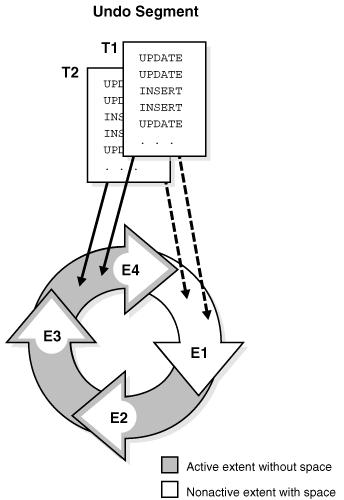
Description of "Figure 12-21 Cyclical Use of Allocated Extents in an Undo Segment"
If the next extent does contain data from an active transaction, then the database must allocate a new extent. Figure 12-22 shows a scenario in which T1 and T2 are writing to E4. When E4 fills up, the transactions cannot continue writing to E1 because E1 contains active undo entries. Therefore, the database allocates a new extent (E5) for this undo segment. The transactions continue writing to E5.
Figure 12-22 Allocation of a New Extent for an Undo Segment
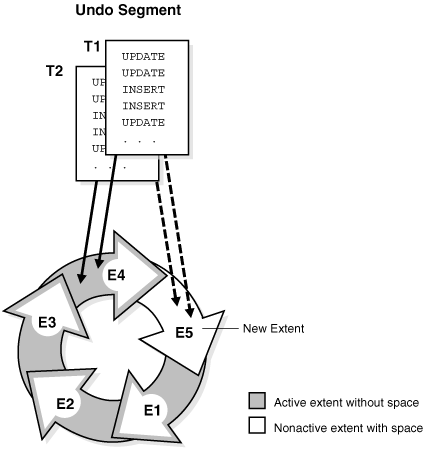
Description of "Figure 12-22 Allocation of a New Extent for an Undo Segment"
See Also:
Oracle Database Administrator's Guide to learn how to manage undo segments
Transaction Rollback
When a ROLLBACK statement is issued, the database uses undo records to roll back changes made to the database by the uncommitted transaction. During recovery, the database rolls back any uncommitted changes applied from the online redo log to the data files. Undo records provide read consistency by maintaining the before image of the data for users accessing data at the same time that another user is changing it.
Temporary Undo Segments
A temporary undo segment is an optional space management container for temporary undo data only.
Undo records for changes to temporary tables are both session-specific and useful only for read consistency and transaction rollback. Before Oracle Database 12c, the database always stored these records in the online redo log. Because changes to temporary objects are not logged in the online redo log, writing undo for temporary objects into temporary undo segments saves space in the online redo log and archived redo log files. The database does not log changes to the undo or changes to the temporary table, which improves performance.
You can set the TEMP_UNDO_ENABLED initialization parameter so that temporary tables store undo data in a temporary undo segment. When this parameter is TRUE, the database allocates temporary undo segments from temporary tablespaces.
See Also:
-
Oracle Database Administrator's Guide to learn about temporary undo segments
-
Oracle Database Reference to learn about the
TEMP_UNDO_ENABLEDinitialization parameter
Segment Space and the High Water Mark
To manage space, Oracle Database tracks the state of blocks in the segment. The high water mark (HWM) is the point in a segment beyond which data blocks are unformatted and have never been used.
MSSM uses free lists to manage segment space. At table creation, no blocks in the segment are formatted. When a session first inserts rows into the table, the database searches the free list for usable blocks. If the database finds no usable blocks, then it preformats a group of blocks, places them on the free list, and begins inserting data into the blocks. In MSSM, a full table scan reads all blocks below the HWM.
ASSM does not use free lists and so must manage space differently. When a session first inserts data into a table, the database formats a single bitmap block instead of preformatting a group of blocks as in MSSM. The bitmap tracks the state of blocks in the segment, taking the place of the free list. The database uses the bitmap to find free blocks and then formats each block before filling it with data. ASSM spread out inserts among blocks to avoid concurrency issues.
Every data block in an ASSM segment is in one of the following states:
-
Above the HWM
These blocks are unformatted and have never been used.
-
Below the HWM
These blocks are in one of the following states:
-
Allocated, but currently unformatted and unused
-
Formatted and contain data
-
Formatted and empty because the data was deleted
-
Figure 12-23 depicts an ASSM segment as a horizontal series of blocks. At table creation, the HWM is at the beginning of the segment on the left. Because no data has been inserted yet, all blocks in the segment are unformatted and never used.
Suppose that a transaction inserts rows into the segment. The database must allocate a group of blocks to hold the rows. The allocated blocks fall below the HWM. The database formats a bitmap block in this group to hold the metadata, but does not preformat the remaining blocks in the group.
In Figure 12-24, the blocks below the HWM are allocated, whereas blocks above the HWM are neither allocated or formatted. As inserts occur, the database can write to any block with available space. The low high water mark (low HWM) marks the point below which all blocks are known to be formatted because they either contain data or formerly contained data.
In Figure 12-25, the database chooses a block between the HWM and low HWM and writes to it. The database could have just as easily chosen any other block between the HWM and low HWM, or any block below the low HWM that had available space. In Figure 12-25, the blocks to either side of the newly filled block are unformatted.
The low HWM is important in a full table scan. Because blocks below the HWM are formatted only when used, some blocks could be unformatted, as in Figure 12-25. For this reason, the database reads the bitmap block to obtain the location of the low HWM. The database reads all blocks up to the low HWM because they are known to be formatted, and then carefully reads only the formatted blocks between the low HWM and the HWM.
Assume that a new transaction inserts rows into the table, but the bitmap indicates that insufficient free space exists under the HWM. In Figure 12-26, the database advances the HWM to the right, allocating a new group of unformatted blocks.
When the blocks between the HWM and low HWM are full, the HWM advances to the right and the low HWM advances to the location of the old HWM. As the database inserts data over time, the HWM continues to advance to the right, with the low HWM always trailing behind it. Unless you manually rebuild, truncate, or shrink the object, the HWM never retreats.
See Also:
-
Oracle Database Administrator's Guide to learn how to shrink segments online
-
Oracle Database SQL Language Reference for
TRUNCATE TABLEsyntax and semantics
Overview of Tablespaces
A tablespace is a logical storage container for segments. Segments are database objects, such as tables and indexes, that consume storage space. At the physical level, a tablespace stores data in one or more data files or temp files.
A database must have the SYSTEM and SYSAUX tablespaces. Figure 12-27 shows the tablespaces in a typical database. The following sections describe the tablespace types.
Permanent Tablespaces
A permanent tablespace groups persistent schema objects. The segments for objects in the tablespace are stored physically in data files.
Each database user is assigned a default permanent tablespace. A very small database may need only the default SYSTEM and SYSAUX tablespaces. However, Oracle recommends that you create at least one tablespace to store user and application data. You can use tablespaces to achieve the following goals:
-
Control disk space allocation for database data
-
Assign a quota (space allowance or limit) to a database user
-
Take individual tablespaces online or offline without affecting the availability of the whole database
-
Perform backup and recovery of individual tablespaces
-
Import or export application data by using the Oracle Data Pump utility (see "Oracle Data Pump Export and Import")
-
Create a transportable tablespace that you can copy or move from one database to another, even across platforms
Moving data by transporting tablespaces can be orders of magnitude faster than either export/import or unload/load of the same data, because transporting a tablespace involves only copying data files and integrating the tablespace metadata. When you transport tablespaces you can also move index data.
See Also:
-
Oracle Database Administrator's Guide to learn how to transport tablespaces
-
Oracle Database Utilities to learn about Oracle Data Pump
-
Oracle Streams Concepts and Administration for more information on ways to copy or transport files
The SYSTEM Tablespace
The SYSTEM tablespace is a necessary administrative tablespace included with the database when it is created. Oracle Database uses SYSTEM to manage the database.
The SYSTEM tablespace includes the following information, all owned by the SYS user:
-
The data dictionary
-
Tables and views that contain administrative information about the database
-
Compiled stored objects such as triggers, procedures, and packages
The SYSTEM tablespace is managed as any other tablespace, but requires a higher level of privilege and is restricted in some ways. For example, you cannot rename or drop the SYSTEM tablespace.
By default, Oracle Database sets all newly created user tablespaces to be locally managed. In a database with a locally managed SYSTEM tablespace, you cannot create dictionary-managed tablespaces (which are deprecated). However, if you execute the CREATE DATABASE statement manually and accept the defaults, then the SYSTEM tablespace is dictionary managed. You can migrate an existing dictionary-managed SYSTEM tablespace to a locally managed format.
Note:
Oracle strongly recommends that you use Database Configuration Assistant (DBCA) to create new databases so that all tablespaces, including SYSTEM, are locally managed by default.
See Also:
-
"Online and Offline Tablespaces" for information about the permanent online condition of the
SYSTEMtablespace -
"Tools for Database Installation and Configuration" to learn about DBCA
-
Oracle Database Administrator's Guide to learn how to create or migrate to a locally managed
SYSTEMtablespace -
Oracle Database SQL Language Reference for
CREATE DATABASEsyntax and semantics
The SYSAUX Tablespace
The SYSAUX tablespace is an auxiliary tablespace to the SYSTEM tablespace. Because SYSAUX is the default tablespace for many Oracle Database features and products that previously required their own tablespaces, it reduces the number of tablespaces required by the database. It also reduces the load on the SYSTEM tablespace.
Database creation or upgrade automatically creates the SYSAUX tablespace. During normal database operation, the database does not allow the SYSAUX tablespace to be dropped or renamed. If the SYSAUX tablespace becomes unavailable, then core database functionality remains operational. The database features that use the SYSAUX tablespace could fail, or function with limited capability.
See Also:
Oracle Database Administrator's Guide to learn about the SYSAUX tablespace
Undo Tablespaces
An undo tablespace is a locally managed tablespace reserved for system-managed undo data (see "Undo Segments"). Like other permanent tablespaces, undo tablespaces contain data files. Undo blocks in these files are grouped in extents.
Automatic Undo Management Mode
A new installation of Oracle Database automatically creates an undo tablespace. Earlier versions of Oracle Database may not include an undo tablespace and use legacy rollback segments instead, known as manual undo management mode. When upgrading to Oracle Database 11g or later, you can enable automatic undo management mode and create an undo tablespace. Oracle Database contains an Undo Advisor that provides advice on and helps automate your undo environment.
A database can contain multiple undo tablespaces, but only one can be in use at a time. When an instance attempts to open a database, Oracle Database automatically selects the first available undo tablespace. If no undo tablespace is available, then the instance starts without an undo tablespace and stores undo data in the SYSTEM tablespace. Storing undo data in SYSTEM is not recommended.
See Also:
-
Oracle Database Administrator's Guide to learn about automatic undo management
-
Oracle Database Upgrade Guide to learn how to migrate to automatic undo management mode
Automatic Undo Retention
In general, it is desirable to retain old undo data as long as possible. After a transaction commits, undo data is no longer needed for rollback or transaction recovery. The database can retain old undo data if the undo tablespace has space for new transactions. When available space is low, the database begins to overwrite old undo data for committed transactions.
Oracle Database automatically provides the best possible undo retention for the current undo tablespace. The database collects usage statistics and tunes the retention period based on these statistics and the undo tablespace size. If the undo tablespace is configured with the AUTOEXTEND option, and if the maximum size is not specified, then undo retention tuning is different. In this case, the database tunes the undo retention period to be slightly longer than the longest-running query, if space allows.
See Also:
Oracle Database Administrator's Guide for more details on automatic tuning of undo retention
Temporary Tablespaces
A temporary tablespace contains transient data that persists only for the duration of a session. No permanent schema objects can reside in a temporary tablespace. A temp file stores temporary tablespace data.
Temporary tablespaces can improve the concurrency of multiple sort operations that do not fit in memory. These tablespaces also improve the efficiency of space management operations during sorts.
When the SYSTEM tablespace is locally managed, a default temporary tablespace is included in the database by default during database creation. A locally managed SYSTEM tablespace cannot serve as default temporary storage.
Note:
You cannot make a default temporary tablespace permanent.
You can specify a user-named default temporary tablespace when you create a database by using the DEFAULT TEMPORARY TABLESPACE extension to the CREATE DATABASE statement. If SYSTEM is dictionary managed, and if a default temporary tablespace is not defined at database creation, then SYSTEM is the default temporary storage. However, the database writes a warning in the alert log saying that a default temporary tablespace is recommended.
See Also:
-
Oracle Database Administrator's Guide to learn how to create a default temporary tablespace
-
Oracle Database SQL Language Reference for the syntax of the
DEFAULT TEMPORARY TABLESPACEclause ofCREATE DATABASEandALTER DATABASE
Tablespace Modes
The tablespace mode determines the accessibility of the tablespace.
Read/Write and Read-Only Tablespaces
Every tablespace is in a write mode that specifies whether it can be written to. The mutually exclusive modes are as follows:
-
Read/write mode
Users can read and write to the tablespace. All tablespaces are initially created as read/write. The
SYSTEMandSYSAUXtablespaces and temporary tablespaces are permanently read/write, which means that they cannot be made read-only. -
Read-only mode
Write operations to the data files in the tablespace are prevented. A read-only tablespace can reside on read-only media such as DVDs or WORM drives.
Read-only tablespaces eliminate the need to perform backup and recovery of large, static portions of a database. Read-only tablespaces do not change and thus do not require repeated backup. If you recover a database after a media failure, then you do not need to recover read-only tablespaces.
See Also:
-
Oracle Database Administrator's Guide to learn how to change a tablespace to read only or read/write mode
-
Oracle Database SQL Language Reference for
ALTER TABLESPACEsyntax and semantics -
Oracle Database Backup and Recovery User's Guide for more information about recovery
Online and Offline Tablespaces
A tablespace can be online (accessible) or offline (not accessible) whenever the database is open. A tablespace is usually online so that its data is available to users. The SYSTEM tablespace and temporary tablespaces cannot be taken offline.
A tablespace can go offline automatically or manually. For example, you can take a tablespace offline for maintenance or backup and recovery. The database automatically takes a tablespace offline when certain errors are encountered, as when the database writer (DBW) process fails in several attempts to write to a data file. Users trying to access tables in an offline tablespace receive an error.
When a tablespace goes offline, the database does the following:
-
The database does not permit subsequent DML statements to reference objects in the offline tablespace. An offline tablespace cannot be read or edited by any utility other than Oracle Database.
-
Active transactions with completed statements that refer to data in that tablespace are not affected at the transaction level.
-
The database saves undo data corresponding to those completed statements in a deferred undo segment in the
SYSTEMtablespace. When the tablespace is brought online, the database applies the undo data to the tablespace, if needed.
See Also:
-
Oracle Database Administrator's Guide to learn how to alter tablespace availability
Tablespace File Size
A tablespace is either a bigfile tablespace or a smallfile tablespace. These tablespaces are indistinguishable in terms of execution of SQL statements that do not explicitly refer to data files or temp files. The difference is as follows:
-
A smallfile tablespace can contain multiple data files or temp files, but the files cannot be as large as in a bigfile tablespace. This is the default tablespace type.
-
A bigfile tablespace contains one very large data file or temp file. This type of tablespace can do the following:
-
Increase the storage capacity of a database
The maximum number of data files in a database is limited, so increasing the size of each data file increases the overall storage.
-
Reduce the burden of managing many data files and temp files
Bigfile tablespaces simplify file management with Oracle Managed Files and Automatic Storage Management (Oracle ASM) by eliminating the need for adding new files and dealing with multiple files.
-
Perform operations on tablespaces rather than individual files
Bigfile tablespaces make the tablespace the main unit of the disk space administration, backup and recovery, and so on.
Bigfile tablespaces are supported only for locally managed tablespaces with ASSM. However, locally managed undo and temporary tablespaces can be bigfile tablespaces even when segments are manually managed.
-
See Also:
-
Oracle Database Administrator's Guide to learn how to manage bigfile tablespaces


